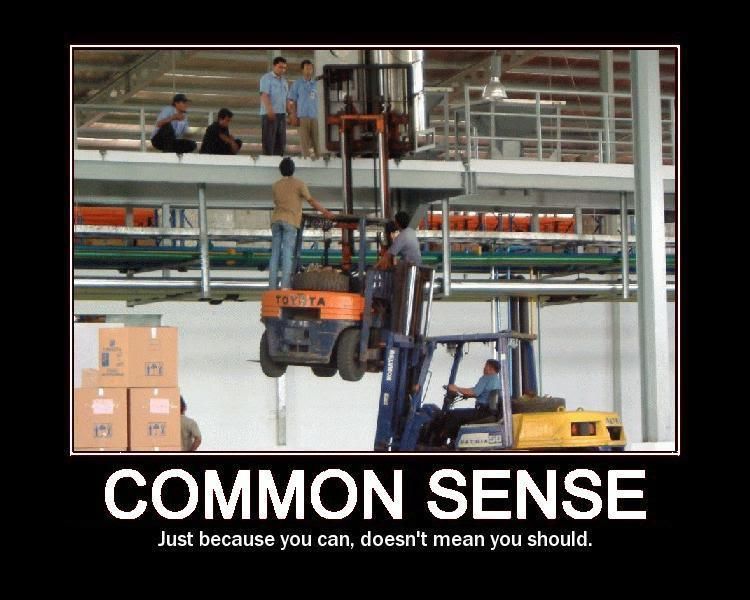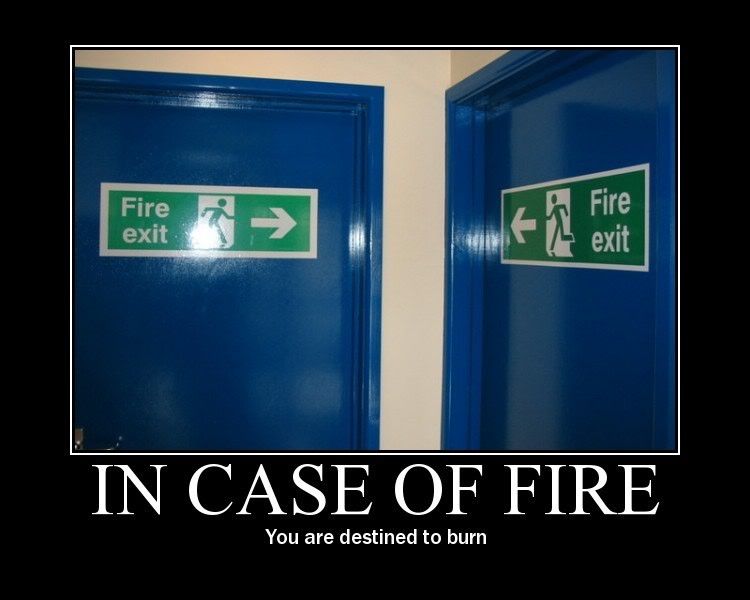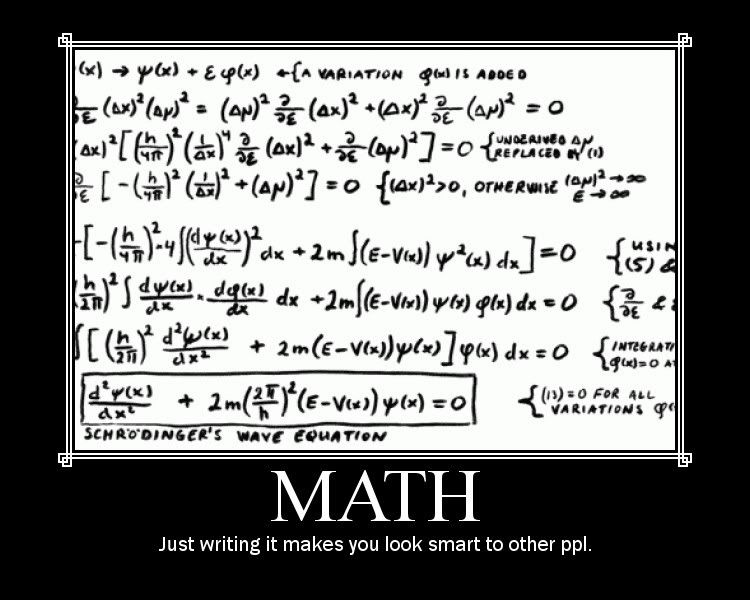GasBandit
Staff member
They all are just antsy ever since 7 8 9.ElJuski said:Okay, I'm banning anyone who makes posts another math poster that gets all the number dorks in a tizzy -_-. Where's the FUNNY, DAMNIT
They all are just antsy ever since 7 8 9.ElJuski said:Okay, I'm banning anyone who makes posts another math poster that gets all the number dorks in a tizzy -_-. Where's the FUNNY, DAMNIT
YOUR FACEElJuski said:Okay, I'm banning anyone who makes posts another math poster that gets all the number dorks in a tizzy -_-. Where's the FUNNY, DAMNIT

Zarvox said:http://www.questionablecontent.net/view.php?comic=593
Math is delicious!



GasBandit said:They all are just antsy ever since 7 8 9.ElJuski said:Okay, I'm banning anyone who makes posts another math poster that gets all the number dorks in a tizzy -_-. Where's the FUNNY, DAMNIT

...and therefore the "given" is wrong. We have proved it is wrong. Therefore, a cannot equal b in the first place, and it cannot be true at ANY point during the problem.DarkAudit said:It's not an assumption that a=b, it's given. To do the proof, you have to work within the framework that a=b from the very start. At any point where a cannot equal b, you're done. You cannot go any further.
It's not the a=b that's the problem. It's the division by zero that invalidates the proof. You might want to bone up a bit on "mathematical proofs" for greater understanding.Rasputin said:...and therefore the "given" is wrong. We have proved it is wrong. Therefore, a cannot equal b in the first place, and it cannot be true at ANY point during the problem.DarkAudit said:It's not an assumption that a=b, it's given. To do the proof, you have to work within the framework that a=b from the very start. At any point where a cannot equal b, you're done. You cannot go any further.
We've established that, in order for a=b, it has to be a=b=0. Now, we prove that a=b=0 is false. Therefore, a=b is invalid, and the given statement is false. Now, using what we have found within the proof, we can say that a=b is a false given from the very beginning.Tinwhistler said:It's not the a=b that's the problem. It's the division by zero that invalidates the proof. You might want to bone up a bit on "mathematical proofs" for greater understanding.Rasputin said:...and therefore the "given" is wrong. We have proved it is wrong. Therefore, a cannot equal b in the first place, and it cannot be true at ANY point during the problem.DarkAudit said:It's not an assumption that a=b, it's given. To do the proof, you have to work within the framework that a=b from the very start. At any point where a cannot equal b, you're done. You cannot go any further.
http://en.wikipedia.org/wiki/Mathematical_proof
http://zimmer.csufresno.edu/~larryc/proofs/proofs.html
http://www.math.uconn.edu/~hurley/math3 ... berger.pdf
ElJuski said:Okay, I'm banning anyone who makes posts another math poster that gets all the number dorks in a tizzy -_-. Where's the FUNNY, DAMNIT




Rasputin said:YOU might want to read up on a little thing called "proof by contradiction", which is what we're given. We want to prove that a cannot equal b, so we are given a=b. We proved a cannot equal b, and therefore the given is a false one.
What the poster is doing, instead, is using faulty math to try to prove 1=2. We are "given" a=b. That means it's absolutely true. We must then prove 1=2 using mathematical steps along the way. 1=2 is our result we must prove, given a=b.The "Proof by Contradiction" is also known as reductio ad absurdum, which is probably Latin for "reduce it to something absurd".
Here's the idea:
1. Assume that a given proposition is untrue.
2. Based on that assumption reach two conclusions that contradict each other.
Tinwhistler said:Rasputin said:YOU might want to read up on a little thing called "proof by contradiction", which is what we're given. We want to prove that a cannot equal b, so we are given a=b. We proved a cannot equal b, and therefore the given is a false one.
We don't want to prove a cannot equal b. The poster is trying to prove that 1=2. That's not proof by contradiction.
http://www.delphiforfun.org/Programs/Ma ... iction.htm
What the poster is doing, instead, is using faulty math to try to prove 1=2. The division by zero is where that proof breaks. However, there's no point in me repeating myself if you're just not getting it, so, that's all I have to say on it.The "Proof by Contradiction" is also known as reductio ad absurdum, which is probably Latin for "reduce it to something absurd".
Here's the idea:
1. Assume that a given proposition is untrue.
2. Based on that assumption reach two conclusions that contradict each other.
Okay, so we try to prove 1=2. We cannot. Therefore we have proven that 1 cannot equal 2, which is, in its nature, a proof by contradiction. While the math wasn't TRYING to do a proof by contradiction, that is what we ended up doing.Tinwhistler said:Rasputin said:YOU might want to read up on a little thing called "proof by contradiction", which is what we're given. We want to prove that a cannot equal b, so we are given a=b. We proved a cannot equal b, and therefore the given is a false one.
We don't want to prove a cannot equal b. The poster is trying to prove that 1=2. That's not proof by contradiction.
http://www.delphiforfun.org/Programs/Ma ... iction.htm
What the poster is doing, instead, is using faulty math to try to prove 1=2. The division by zero is where that proof breaks. However, there's no point in me repeating myself if you're just not getting it, so, that's all I have to say on it.The "Proof by Contradiction" is also known as reductio ad absurdum, which is probably Latin for "reduce it to something absurd".
Here's the idea:
1. Assume that a given proposition is untrue.
2. Based on that assumption reach two conclusions that contradict each other.
That's one way of looking at it. But the proof still broke at the division by 0, not at the a=b. That's the whole point. At the division by 0 step, the entire proof falls apart. not at the a=b step, which is a "given statement".Rasputin said:Okay, so we try to prove 1=2. We cannot. Therefore we have proven that 1 cannot equal 2, which is, in its nature, a proof by contradiction. While the math wasn't TRYING to do a proof by contradiction, that is what we ended up doing.
That's the whole point that's me and DarkAudit have been trying to make to you. a=b is an axiom. It's not where the proof fails. a can equal b. You just can't go from a=b to 1=2, and the failure point is the division by zero. This kind of proof reading (pun intended) is fundamental math.The study of geometry is the first place I encountered an axiom
system.
You start with certain "undefined objects," in this case "point,"
"line," "plane," "length," "area," "between," etc. Then you are given
certain statements about them which you are to accept as true. These
are called Postulates or Axioms. They appear in the very first part of
your book on Plane Geometry. Examples might be:
Did I ever, EVER say that since a=b is false for THIS problem, that it must be false for ALL problems? NOTinwhistler said:That's one way of looking at it. But the proof still broke at the division by 0, not at the a=b. That's the whole point. At the division by 0 step, the entire proof falls apart. not at the a=b step, which is a "given statement".Rasputin said:Okay, so we try to prove 1=2. We cannot. Therefore we have proven that 1 cannot equal 2, which is, in its nature, a proof by contradiction. While the math wasn't TRYING to do a proof by contradiction, that is what we ended up doing.
Look at the poster again: "Given: a=b" Is the first line. The "given" line is the "postulate" or "axiom" of the proof. These are to be accepted as absolutely true. Thus the a=b line is not where it breaks down.
http://en.wikipedia.org/wiki/Axiom
http://mathforum.org/library/drmath/view/54726.html
That's the whole point that's me and DarkAudit have been trying to make to you. a=b is an axiom. It's not where the proof fails. a can equal b. You just can't go from a=b to 1=2, and the failure point is the division by zero. This kind of proof reading (pun intended) is fundamental math.The study of geometry is the first place I encountered an axiom
system.
You start with certain "undefined objects," in this case "point,"
"line," "plane," "length," "area," "between," etc. Then you are given
certain statements about them which you are to accept as true. These
are called Postulates or Axioms. They appear in the very first part of
your book on Plane Geometry. Examples might be:
Just wanted to point this statement out.Tinwhistler said:Look at the poster again: "Given: a=b" Is the first line. The "given" line is the "postulate" or "axiom" of the proof. These are to be accepted as absolutely true. Thus the a=b line is not where it breaks down.
I'm sorry, Ed. It's just that, well, he's WRONG, and I'm fixing it.Edrondol said:I've never had to lock a thread because of non-offensive math before. How odd would that be?
Let's at least try to keep a veneer of a topic here!
Here's where anyone else would post a funny motivational poster, but alas I have none. Pretend there's one here with a scathing picture of Ravenpoe's avatar.
Subject:
Math Nerds
Tag line:
Apparently get why e=mc^2 but can't make a fucking poster about it.

Excellent point. And now for a witty retort.Rasputin said:I'm sorry, Ed. It's just that, well, he's WRONG, and I'm fixing it.
I've said all that I can say about it. If he/they still don't believe me, then they're in some sort of fantasy world. I know my math. I have many people around me who know math. I and they all have the same thoughts on this proof.



asleep at the wheel, man.GasBandit said:And here I didn't post that because I thought it was intentional and ironic. Shows what I get for assuming.

